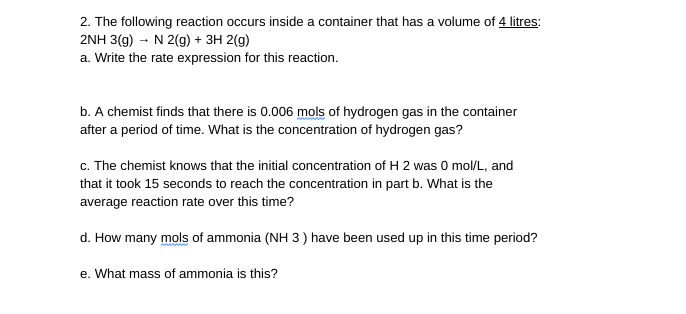2. The following reaction occurs inside a container that has a volume of 4 litres: 2NH 3(g) - N 2(g) + 3H 2(g) a. Write the rate expression for this reaction. b. A chemist finds that there is 0.006 mols of hydrogen gas in the container after a period of time. What is the concentration of hydrogen gas? c. The chemist knows that the initial concentration of H 2 was 0 mol/L, and that it took 15 seconds to reach the concentration in part b. What is the average reaction rate over this time? d. How many mols of ammonia (NH 3) have been used up in this time period? e. What mass of ammonia is this?
2. The following reaction occurs inside a container that has a volume of 4 litres: 2NH 3(g) - N 2(g) + 3H 2(g) a. Write the rate expression for this reaction. b. A chemist finds that there is 0.006 mols of hydrogen gas in the container after a period of time. What is the concentration of hydrogen gas? c. The chemist knows that the initial concentration of H 2 was 0 mol/L, and that it took 15 seconds to reach the concentration in part b. What is the average reaction rate over this time? d. How many mols of ammonia (NH 3) have been used up in this time period? e. What mass of ammonia is this?
Chemistry & Chemical Reactivity
10th Edition
ISBN:9781337399074
Author:John C. Kotz, Paul M. Treichel, John Townsend, David Treichel
Publisher:John C. Kotz, Paul M. Treichel, John Townsend, David Treichel
Chapter14: Chemical Kinetics: The Rates Of Chemical Reactions
Section: Chapter Questions
Problem 10PS: Nitrosyl bromide, NOBr, is formed from NO and Br2: 2 NO(g) + Br2(g) 2 NOBr(g) Experiments show that...
Related questions
Question
When given a chemical equation, how may I find the rate expression, concentration, average reaction rate, mols, and mass?

Transcribed Image Text:2. The following reaction occurs inside a container that has a volume of 4 litres:
2NH 3(g) - N 2(g) + 3H 2(g)
a. Write the rate expression for this reaction.
b. A chemist finds that there is 0.006 mols of hydrogen gas in the container
after a period of time. What is the concentration of hydrogen gas?
c. The chemist knows that the initial concentration of H 2 was 0 mol/L, and
that it took 15 seconds to reach the concentration in part b. What is the
average reaction rate over this time?
d. How many mols of ammonia (NH 3) have been used up in this time period?
e. What mass of ammonia is this?
Expert Solution
This question has been solved!
Explore an expertly crafted, step-by-step solution for a thorough understanding of key concepts.
This is a popular solution!
Trending now
This is a popular solution!
Step by step
Solved in 5 steps with 4 images

Knowledge Booster
Learn more about
Need a deep-dive on the concept behind this application? Look no further. Learn more about this topic, chemistry and related others by exploring similar questions and additional content below.Recommended textbooks for you

Chemistry & Chemical Reactivity
Chemistry
ISBN:
9781337399074
Author:
John C. Kotz, Paul M. Treichel, John Townsend, David Treichel
Publisher:
Cengage Learning

Chemistry & Chemical Reactivity
Chemistry
ISBN:
9781133949640
Author:
John C. Kotz, Paul M. Treichel, John Townsend, David Treichel
Publisher:
Cengage Learning

General Chemistry - Standalone book (MindTap Cour…
Chemistry
ISBN:
9781305580343
Author:
Steven D. Gammon, Ebbing, Darrell Ebbing, Steven D., Darrell; Gammon, Darrell Ebbing; Steven D. Gammon, Darrell D.; Gammon, Ebbing; Steven D. Gammon; Darrell
Publisher:
Cengage Learning

Chemistry & Chemical Reactivity
Chemistry
ISBN:
9781337399074
Author:
John C. Kotz, Paul M. Treichel, John Townsend, David Treichel
Publisher:
Cengage Learning

Chemistry & Chemical Reactivity
Chemistry
ISBN:
9781133949640
Author:
John C. Kotz, Paul M. Treichel, John Townsend, David Treichel
Publisher:
Cengage Learning

General Chemistry - Standalone book (MindTap Cour…
Chemistry
ISBN:
9781305580343
Author:
Steven D. Gammon, Ebbing, Darrell Ebbing, Steven D., Darrell; Gammon, Darrell Ebbing; Steven D. Gammon, Darrell D.; Gammon, Ebbing; Steven D. Gammon; Darrell
Publisher:
Cengage Learning

Chemistry for Engineering Students
Chemistry
ISBN:
9781337398909
Author:
Lawrence S. Brown, Tom Holme
Publisher:
Cengage Learning

Chemistry: The Molecular Science
Chemistry
ISBN:
9781285199047
Author:
John W. Moore, Conrad L. Stanitski
Publisher:
Cengage Learning

Chemistry
Chemistry
ISBN:
9781305957404
Author:
Steven S. Zumdahl, Susan A. Zumdahl, Donald J. DeCoste
Publisher:
Cengage Learning